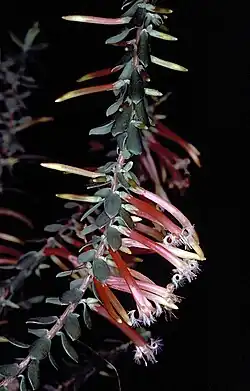Styphelia hainesii
| Styphelia hainesii | |
|---|---|

| |
| In the Australian National Botanic Gardens | |
| Scientific classification | |
| Kingdom: | Plantae |
| Clade: | Tracheophytes |
| Clade: | Angiosperms |
| Clade: | Eudicots |
| Clade: | Asterids |
| Order: | Ericales |
| Family: | Ericaceae |
| Genus: | Styphelia |
| Species: | S. hainesii
|
| Binomial name | |
| Styphelia hainesii | |
Styphelia hainesii is a species of flowering plant in the heath family Ericaceae and is endemic to the south coast of Western Australia. It is a bushy shrub with egg-shaped leaves, the narrower end towards the base, and red, tube-shaped flowers arranged singly in leaf axils.
Description
Styphelia hainesii is a bushy shrub that typically grows to a height of 0.3–2 m (1 ft 0 in – 6 ft 7 in). Its leaves are egg-shaped with the narrower end towards the base, 6.3–10.5 mm (0.25–0.41 in) long, rarely with a small, sharp point on the tip. The flowers are usually borne singly or pairs in leaf axils and are nearly sessile with broad, blunt bracteoles less than 4 mm (0.16 in) long. The sepals are almost pointed, about 13 mm (0.51 in) long, the petals red, nearly 19 mm (0.75 in) long and joined at the base, forming a tube with 5 dense tufts of hairs inside, above the base. Flowering occurs from March to November.[2][3]
Taxonomy
Styphelia hainesii was first described in 1864 by Ferdinand von Mueller in his Fragmenta phytographiae Australiae.[4][5] The specific epithet (hainesii) honours William Haines.[5][6]
Distribution and habitat
This styphelia occurs in sandy soils over limestone in limestone slopes, sand dunes and flats in near-coastal sites in the Coolgardie, Esperance Plains, Hampton and Mallee bioregions of southern Western Australia.[3]
Conservation status
Styphelia hainesii is listed as "not threatened" by the Western Australian Government Department of Biodiversity, Conservation and Attractions.[3]
References
- ^ "Styphelia hainesii". Plants of the World Online. Retrieved 17 December 2023.
- ^ Bentham, George; von Mueller, Ferdinand (1868). Flora Australiensis. Vol. 4. London: Lovell Reeve & Co. p. 148. Retrieved 18 January 2024.
- ^ a b c "Styphelia hainesii". FloraBase. Western Australian Government Department of Biodiversity, Conservation and Attractions.
- ^ "Styphelia hainesii". APNI. Retrieved 18 January 2024.
- ^ a b von Mueller, Ferdinand (1864). Fragmenta phytographiae Australiae. Vol. 4. Melbourne: Victorian Government Printer. p. 96. Retrieved 14 December 2023.
- ^ Sharr, Francis Aubi; George, Alex (2019). Western Australian Plant Names and Their Meanings (3rd ed.). Kardinya, WA: Four Gables Press. p. 213. ISBN 9780958034180.